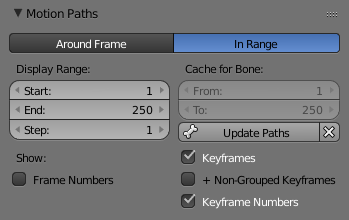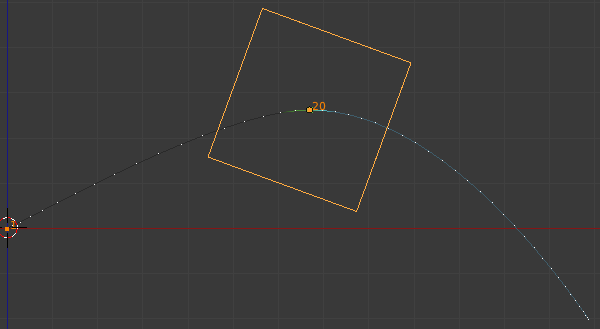Motion Paths¶
Reference
Reference
This feature allows you to visualize the motion of points as paths over a series of frames. These points can be object origins and bone joints.
Before we look at its options, let us first see how to display/hide these paths. Unlike Ghost, you have to do it manually and you have to first select the bones you want to show/hide the motion paths. Then,
- To show the paths (or update them, if needed), click on the Calculate Path button.
- To hide the paths, click on the Clear Paths button.
Note
Remember that only selected bones and their paths are affected by these actions!
The paths are drawn in a light shade of gray for unselected points, and a slightly blueish gray for selected ones. Around the current frame a glow indicate the direction of movement: blue towards future frames and green towards the past. Each frame is displayed by a small white dot on the paths.
As with ghosts, the paths are automatically updated when you edit your poses/keyframes,
and they are also active during animation playback. Alt-A is
only useful when the Around Current Frame option is enabled.
Options¶

The Motion Paths Panel in the Armature tab.
- Type
- Around Frame
- Display paths of points within a fixed number of frames around the current frame. When you enable this button, you get paths for a given number of frames before and after the current one (again, as with ghosts).
- In Range
- Display paths of points within specified range.
- Display Range
- Before, After
- Number of frames to show before and after the current frame (only for Around Current Frame Onion-skinning method).
- Start, End
- Starting and Ending frame of range of paths to display/calculate (not for Around Current Frame Onion-skinning method).
- Step
- This is the same as the Step for ghosts. It allows you to only display on the path one frame for each n ones. Mostly useful when you enable the frame number display (see below), to avoid cluttering the 3D Views.
- Cache/Cache for Bone
- From, To
- These are the start/end frames of the range in which motion paths are drawn. You cannot modify this range without deleting the motion path first.
- Calculate/Update Paths
If no paths have been calculated, Calculate Paths will create a new motion path in cache based on the options specified in the pop-up menu or Operator panel.
If a path has already been calculated, Update Paths will update the path shape to the current animation. To change the frame range of the calculated path, you need to delete the path and calculate it again.
- Start, End
- These are the start/end frames of the range in which motion paths are drawn. You have to Calculate Paths again if you modify this setting, to update the paths in the 3D Views. Note that unlike with ghosts, the start frame is inclusive (i.e. if you set Start to 1, you will really see the frame 1 as starting point of the paths...).
- Bake Location
- Bones only – By default, you get the tips’ paths. By changing this setting to Tails, you will get the paths of the bone’s roots (remember that in Blender UI, bones’ roots are called “heads”...). You have to Calculate Paths again if you modify this setting, to update the paths in the 3D Views.
- Clear Paths
X - Clears paths on all objects/bones or just the selected ones when holding
Shift.
Show¶
- Frame Numbers
- When enabled, a small number appears next to each frame dot on the path, which is of course the number of the corresponding frame.
- Keyframes
- When enabled, big yellow square dots are drawn on motion paths, showing the keyframes of their bones (i.e. only the paths of keyed bones at a given frame get a yellow dot at this frame).
- + Non-Grouped Keyframes
- For bone motion paths, it searches the whole Action for keyframes instead of in groups with matching name only (this is slower).
- Keyframe Numbers
- When enabled, you will see the numbers of the displayed keyframes, so this option is obviously only valid when Show Keys is enabled.
Example¶

An example of a motion path of a armature.
